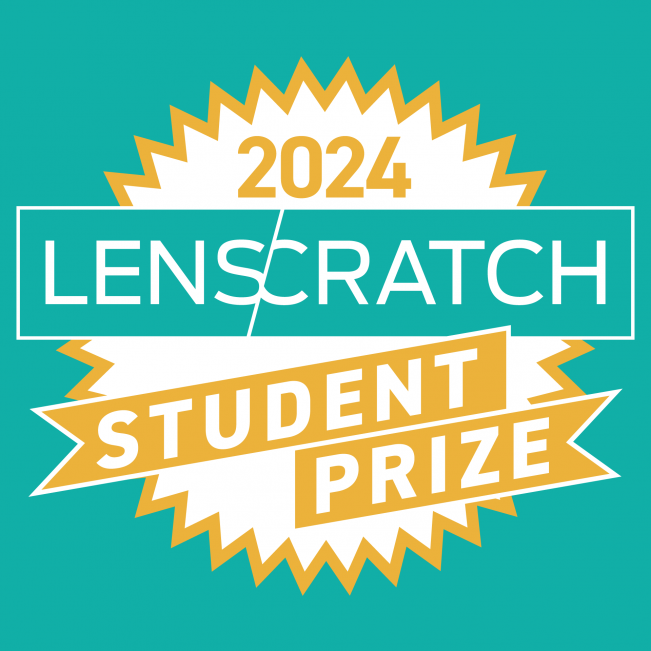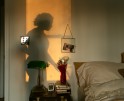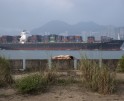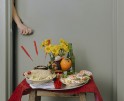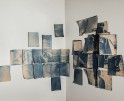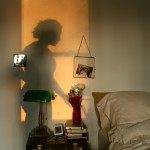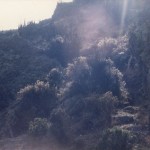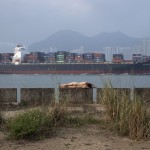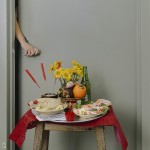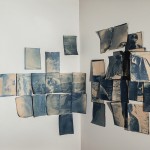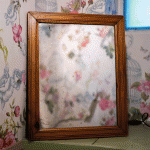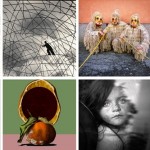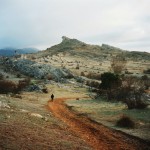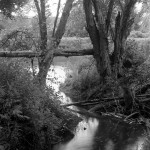The 2024 Lenscratch 3rd Place Student Prize Winner: Mehrdad Mirzaie
It is with pleasure that the jurors announce the 2024 Lenscratch Student Prize 3rd Place Winner, Mehrdad Mirzaie was selected for her project, Imago, and is currently attending the University of Arizona working towards an MFA. The 3rd Place Winner receives a $500 cash prize, a feature on Lenscratch , a mini exhibition on the Curated Fridge, and a a Lenscratch T-shirt and Tote.
The role of the photographer is in flux. What is our job as image-makers? What obligations do we have to the past, to the future, to the photograph itself? While helping jury the Lenscratch Student Prize this year, I found myself particularly drawn to Mehrdad’s work because they question the nature of the physical image. Using a number of techniques and print types Mehrdad is able to evoke haunting images. This word is critical, as it suggests, not nostalgia, but a continuing relationship between past and present.
I was honored to have this conversation with Mehrdad. It is one I hope to continue into the future as it is critical to understanding where photography might be headed.
An enormous thank you to our jurors: Aline Smithson, Founder and Editor-in-Chief of Lenscratch, Educator and Artist, Daniel George, Submissions Editor of Lenscratch, Educator and Artist, Linda Alterwitz, Art + Science Editor of Lenscratch and Artist, Kellye Eisworth, Managing Editor of Lenscratch, Educator and Artist, Alexa Dilworth, Independent Writer, Editor, Curator, Former Publishing and Awards Director; Senior Editor, CDS Books Center for Documentary Studies at Duke University, Kris Graves, Director of Kris Graves Projects, photographer and publisher based in New York and London, Elizabeth Cheng Krist, Former Senior Photo Editor with National Geographic magazine and founding member of the Visual Thinking Collective, Hamidah Glasgow, Director of the Center for Fine Art Photography, Fort Collins, CO, Yorgos Efthymiadis, Artist and Founder of the Curated Fridge, Samantha Johnston, Executive Director of the Colorado Photographic Arts Center, Drew Leventhal, Artist and Publisher, winner of the 2022 Lenscratch Student Prize, Allie Tsubota, Artist and Educator, winner of the 2021 Lenscratch Student Prize, Raymond Thompson, Jr., Artist and Educator, winner of the 2020 Lenscratch Student Prize, Guanyu Xu, Artist and Educator, winner of the 2019 Lenscratch Student Prize, Shawn Bush, Artist, Educator, and Publisher, winner of the 2017 Lenscratch Student Prize.
Mehrdad Mirzaie, an Iranian multidisciplinary artist now residing in the United States, centers his endeavors on the image-based medium, particularly emphasizing the reinterpretation of historical imagery and the interplay between bygone eras and contemporary contexts. His practice is marked by an exploration of the inherent potency of images as conduits for conveying historical narratives. His fervent interest in archives, image analysis, and alternative artistic processes leads him to delve into the intricate relationship between history and storytelling.
Mirzaie’s pursuits extend to a focused exploration of the history of Iranian photography alongside his artistic endeavors. Engaging as a curatorial assistant at the Northlight Gallery, he delves into researching the historical aspects of photography in Iran. Presently, he is immersed in pursuing an MFA in photography at Arizona State University.
Follow Mehrdad Mirzaie on Instagram: @mrdadmirzaie/
Follow the Tasvir Project on Instagram: @tasvirproject
Imago (Ongoing Project 2021-)
My practice is characterized by working with a diverse array of historical images, whether through the curation of new archives or the reinterpretation of existing ones. I firmly believe in the transformative power of historical imagery to inform the present and shape the future. By scrutinizing historical images and the thought images they evoke, I aim to challenge conventional interpretations of the past.
I use historical imagery to reevaluate and reconstruct our collective memory. I define my role as a storyteller, weaving together various narratives from the past and present to foster a deeper understanding of history. Through my practice, I seek to prompt reflection, provoke questions, and encourage viewers to reconsider their preconceived notions of history. – Mehrdad Mirzaie,
Mehrdad, congratulations! Thank you so much for taking the time to talk with me about your project. I want to start on a more abstract scale. In an interview with Negar Farajiani, you opened your article by asking, “What should an artist do? When, where, how, and for what purpose?” So let me flip the question back at you. What do you see as the role of the artist/photographer today in the contemporary world? Where should we fit into the social discourse?
Thank you so much, and I appreciate your attention. It is an honor and a pleasure to have this opportunity.
This interview is from almost three years ago, and it is interesting for me to revisit this question. I must say, I have changed a lot since then. Being an artist/photographer in this period of history is challenging. In a time when anyone in society can capture an image with their mobile phone or amateur camera and share it on social media in less than a minute, the work of a photographer or artist using images becomes difficult. Perhaps in recent decades, the production of images was a need that society relied on photographers for, but now I think this role has changed. The role of the contemporary artist/photographer could be to add notions, points of view, and imagination to their artwork/photograph, preserving, creating, and saving something important for life. These imaginative ideas are something a camera alone cannot create or save. Of course, the camera has its own aesthetic, but it is crucial what the artist adds to the surface of the artwork/photograph.
How has the work you have been making changed since you left Iran to study here in the United States?
Honestly, my work has changed significantly. While I can’t quantify it precisely, the changes are quite evident. Before emigrating, I primarily used my camera for taking photographs. In the past two years, however, I have shifted towards creating images. The distinction between taking a photo and making an image has become a central focus for me recently. I now spend more time working with archives, found photographs, and documents. I dedicate time in the studio to using photography to create images or photographic installations. Conceptually and philosophically, I still hold onto the ideas I had before emigrating, but I have found a completely different method for producing images, and I am pleased with these changes.
The project you shared with us, Imago, deals with bodies and portraits. They have been printed, folded, cut, and rearranged. It is a process of deformation and reformation in my eyes. Are you using these processes to create new representations of those that have been lost or to reflect the violence that created such images (or both)?
I use these processes (gelatin silver, amateur digital prints, alternative processes, transfer prints, etc.) and fragile, non-archival materials (paper, cardboard, glass, etc.) to create my images. The fragility, instability, blurriness, and fluidity of these techniques and materials help me expand my ideas about thought images and historical images. To put it more explicitly, it’s like thinking with images and visual elements. Meanwhile, all these ideas and images are a kind of autobiographical response to what I have experienced or am thinking. I approach this with a very specific point of view, knowing that I cannot tell history; these are all stories I can tell based on my experience or knowledge, and nothing more.
So, what image do I reproduce? Most of the subjects I am currently engaged with are about those who have disappeared or lost their lives due to specific socio-political situations.
You work primarily with archival images, historical images. What can such images teach us about where we have been and where we are going?
In my artistic practice, I strive to maintain a balance between the essence of the image and the subject. While achieving complete success is rare, I consistently make the effort. What does this bring to the audience? My focus is less on teaching and more on preservation and rereading—rereading concepts, historical facts, and subjects like politics, history, and society. For me, the act of remembering can be very political and transformative, particularly in closed, controlling, and oppressive systems. This concept of remembering is the opposite of nostalgia; it involves creating a dialectical image from the collective memories of a society. These images can destabilize the present by being influenced by past experiences and keep the future hopeful. The images I aim to create provide a platform for rereading things that seem rigid and unchangeable. While they are fed by historical images, their purpose is to continuously re-read historical concepts, not just revisit a concluded past.
Is there anything new coming up that you are excited about?
Yes. Along with my emigration, I have started a research project at ASU University with another artist and scholar named Sara Abbaspoor. This project is an old idea and concern that I have been engaged with for years, and now I have the opportunity to work on it more seriously and practically. The project is called “Tasvir.” The Tasvir Project is an independent and focused initiative on studying the history of photography in Iran and archiving photo-based works from Iran. Its goal is to collect and archive important information and resources related to Iranian photographers, photo-based artists, academic articles, and critical analyses in this field. This project emerged from a need we felt daily. The main goal is to create a platform that makes it easier to access information and connect with active individuals in this field. It functions like a roadmap, nothing more. The primary aim is to facilitate communication and recognition of artists and activists in this domain. We strive to ensure this archive is active from the very beginning, helping researchers, writers, and scholars to advance their research more easily.
The connection between this project and my own artistic practice is very direct. When we talk about concepts such as rereading and preservation, I am also trying to pursue these ideas in the history of photography and the visual culture of Iran, my home country. I see the Tasvir as a vast collective project, a place where artists and writers can find each other at the core.
Thank you for your time and this conversation!
Posts on Lenscratch may not be reproduced without the permission of the Lenscratch staff and the photographer.
Recommended
-
The 2024 Lenscratch Student Prize Honorable Mention Winner: Natalie ArruéJuly 28th, 2024
-
The 2024 Lenscratch Student Prize Honorable Mention Winner: Joseph Ladrón de GuevaraJuly 27th, 2024
-
The 2024 Lenscratch Student Prize Honorable Mention Winner: Andrew ZouJuly 26th, 2024
-
The 2024 Lenscratch Student Prize Honorable Mention Winner: Anh NguyenJuly 25th, 2024
-
The 2024 Lenscratch 3rd Place Student Prize Winner: Mehrdad MirzaieJuly 24th, 2024


